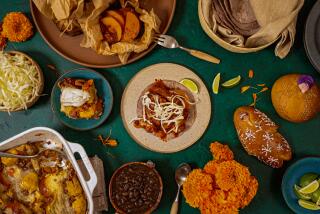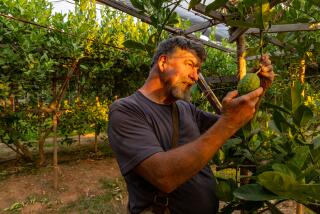Celebrating the Jewish holiday of Tu Bishvat

- Share via
Imagine turning Tax Day into a holiday. That’s what happened with Tu Bishvat, the 15th day of the Jewish month of Shvat, which is Thursday.
During the time of the Holy Temple in Jerusalem, Tu Bishvat was the date for determining the age of fruit trees in order to calculate how much tax was owed on the harvest. After the temple was destroyed about 2,000 years ago and most of the Jews were exiled, Tu Bishvat became a festival celebrated by eating fruit associated with the land of Israel.
In the Talmud, Tu Bishvat is called the New Year of Trees, and some attribute religious meaning to the occasion. They believe that on Tu Bishvat, it is decided how well the trees will grow in the coming year (like Rosh Hashanah, the day of divine judgment, for humans). However, in the early 1900s, Jews living in Palestine began planting trees for the holiday and this custom took hold. Today, the holiday is mainly a cultural celebration marked by tree planting ceremonies at schools rather than a religious event, a sort of Jewish Earth Day.
This year, there will be poignancy in the Tu Bishvat festivities because of the Mt. Carmel forest fire in Israel in December, in which dozens of people died and thousands of acres of land were scorched. Emphasis will be placed on rehabilitation and restoration of the forest.
The most popular way to honor the holiday, which some call the Festival of Fruit, is to serve a Tu Bishvat tray with an enticing selection of dried fruits and nuts, a custom that pleases nutritionists, vegetarians and lovers of raw foods. Dried fruit is highlighted because Tu Bishvat takes place in January or February, traditionally not the time when fruits ripen, though fresh fruits are included too.
For cooks, the holiday is a good reminder of the value of dried fruits. Their flavor is the concentrated essence of the fruit and their texture makes them particularly useful in sweets and baked goods.
Biblical fruits, notably grapes, figs, pomegranates and dates, get priority on the Tu Bishvat table. A custom in some households is to serve 15 kinds of fruits to allude to the holiday’s date. Oranges are featured because they have long been grown in Israel. Almonds are associated with Tu Bishvat not only because they are mentioned in the Torah but also because the almond tree is considered the herald of Tu Bishvat. “The almond tree is flowering,” begins a popular Israeli children’s Tu Bishvat song, and continues, “Tu Bishvat has arrived, the holiday of trees.”
As a child in Washington, D.C., my first experience of Tu Bishvat was at Hebrew school, where the teacher gave us pieces of carob to taste and said it was fruit from the Holy Land. We felt sorry for Israeli children, thinking that this hard, dry fruit was what they had to eat. Years later, I learned that eating carob was a Tu Bishvat custom in Eastern Europe because the hardy fruit traveled well and there weren’t many other fruits available.
Wine aficionados have a good reason to look forward to Tu Bishvat. A custom started in the Middle Ages by Kabbalists in what is now Israel of having a Tu Bishvat Seder somewhat similar to the Passover Seder has recently been revived. This ceremony calls for tasting four glasses of wine, along with fruits and nuts to symbolize the four seasons.
And then there are such time-honored Tu Bishvat treats as compotes of apricots and prunes, cakes studded with fruits and nuts and bar cookies with raisins, dates and sweet spices. Some Israelis sweeten their cakes with date or carob syrup or serve citrus fruit salads with dried fruit. For this kid-friendly festival, there are plenty of sweets that children enjoy preparing, such as chocolate raisin coconut candies. One particular favorite is a sweet challah kugel with dried cherries and almonds.
Several synagogues and Jewish organizations around Los Angeles are having Tu Bishvat events. For a list of some of them, go to https://www.jkidla.org.
Dried fruit: How to store and use
- Storing dried fruit in an airtight container in the refrigerator or freezer keeps it fresher and prevents it from drying out and becoming too hard.
- If dried fruit does get too dry and hard, microwave it briefly with a little water in a covered container on low power, or soak it in hot water to plump it before adding to cake batters or bread dough. If you’re using dried fruit in a cooked dish, it will soften after a few minutes of simmering.
More to Read
Eat your way across L.A.
Get our weekly Tasting Notes newsletter for reviews, news and more.
You may occasionally receive promotional content from the Los Angeles Times.










